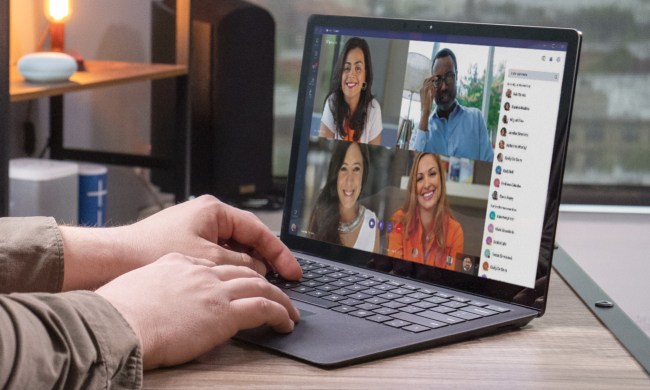There are two groups of people you don’t want to aggravate in this world: florists and environmentalists. We learned the first after making “disparaging remarks” (their words, not ours) about the longevity of flowers in this year’s Valentine’s Day gift guide, prompting a fiery letter from the Society of American Florists. The second piece of knowledge was gleaned after criticizing LG’s “environmentally friendly” Skycharger at CES this year.
In the latter case, the flak came screaming in when we criticized the allegedly “green” nature of the Skycharger itself, a wind- and solar-powered stand parked outside the convention center that recharged cell phones for attendees using renewable energy. Our complaint: offering a service that puts a completely imperceptible dent in electricity usage at the mother of all resource-wasting events does not a “green” company make, despite obvious efforts to enjoy the marketing and publicity boost such corporate posturing naturally engenders.
Commentators took this to mean that we would chalk up all “steps in the right direction” as completely worthless, simply because they weren’t big enough to change the world. However, astute readers will note that what we’re really contesting here isn’t whether or not the service makes sense, and can genuinely do some good, but rather the whole marketing angle. To be blunt, from Main Street to Wall Street and half the online boutiques in between, the term “green” is being hijacked by big business and used to promote halfhearted stabs at cleaning up their public image in place of real progress.
Consider the Skycharger a prime example. According to LG, it supplies a maximum of 1.8 kilowatt hours of electricity. The manufacturer deployed the device during show hours for four days of CES, meaning it got around 33 hours of use, translating to a whopping 59.4 killowatt hours saved off the grid, if it was running full bore the whole time. In common parlance, that translates to a maximum of about $6.59 saved in electricity for the whole event. Call us skeptics, but we’re pretty sure you could find a lone sign among the dozens at LG’s booth that sucked that much juice down single-handedly in any given day. That’s not to mention the carbon emitted to bring it out to Las Vegas, the paper used in its promotional materials, and of course all the raw materials used to build the thing.

LG Skycharger
Here’s where people tend to disagree. We say the gesture’s next to worthless. Others say such a move sees big business heading in the right direction, or something along those lines. But the harsh reality is that it’s one thing when individuals make small strides, and another when businesses do. There’s even a name for it: greenwashing.

Plastics made from corn also seem to capture the public’s imagination, like this model Fujitsu showed off at CES. Most people imagine a material that melts away into the Earth like corn husks when its useful life has expired. But none of the companies using this “miracle material” to build gadgets like to mention that it can only be composted in rare, high-temperature commercial composters, or that a small amount of it can foul up a recycled batch of regular plastic if mixed in. Given those two caveats, most informed environmentalists actually heap more scorn upon it than regular plastic, but it continues to grow in popularity solely for its presumed environmental friendliness.
Having “your heart in the right place” only counts when you’re doing things out of the goodness of your heart, and that’s never the case with businesses, which, by their very nature, place profits above environmentalism. (Apart from, say, firms which clean up toxic waste spills, in which case filthy lucre and rescuing the ecosystem from three-headed geese go hand-in-hand.) We have no argument with the hippies here in DT’s home city of Portland who go out of their way to save a gallon of water while the city’s continuously running water fountains waste it all day. It makes only the smallest difference, sure, but those folks really do have their intentions straight. The issue arises when corporations do the same thing and try to paint themselves as angels of conservation to consumers. That’s business, where all “good intentions” translate to “thinly veiled PR.” Somebody should be counting the damn watts.

Consumers are so desperate to contribute their part towards cleaning up the environment that corporations are ready to exploit that sentiment by doing literally anything – and sometimes next to nothing – to build that illusion. But if we let them off the hook there, meaningless gestures are all we’ll ever get.
Big business needn’t grind to a halt while we figure out more environmentally conscious ways of doing things, but we’re tired of seeing commercial ventures trot out these weak green products to satisfy headline browsers when we should really be demanding more as a society. If we, as consumers, are content to let companies peddle us “eco-friendly” products that save a couple pennies in electricity every year, and then pat ourselves on the back for buying them, we’ll never see the harder-won progress required to make a meaningful impact on our planet.
As shoppers, we’re really the ones in power, and the best way to stop this rain of PR speak is to quit falling for it. It’s a tough proposition, but many organizations are already making strides at calling companies out on their bluffs. The University of Oregon, for instance, hosts a Greenwashing Index that allows consumers to rank just how bogus different claims are, and even the environuts over at Greenpeace have caught on with their own version.

http://stopgreenwash.org/
But you don’t need someone else to do the work for you – all of us can pull it off ourselves. So before grabbing the box swathed in green, do the math. Crunch the numbers. Do the research. Make the calls. And figure out whether you’re buying a piece of gadgetry that’s genuinely helping to save the environment, or just a feel-good hoax. Because while she may be a bit fickle sometimes, after millennia of Darwinian evolution to thin the herd, we’d like to think that in recent years, Mother Nature didn’t raise any fools.




